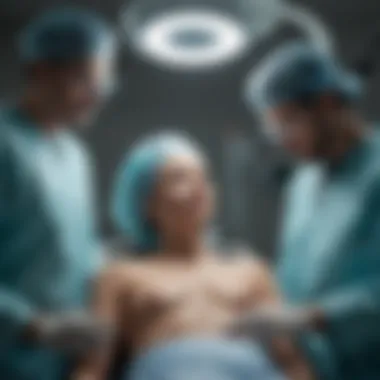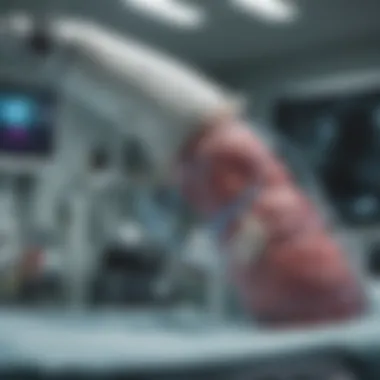Intraoperative C-Arm Imaging: Advancements in Surgical Technology


Intro
Intraoperative C-arm imaging has revolutionized the landscape of surgical procedures, providing real-time visualization of anatomy and aiding surgeons in making critical decisions during operations. This technology enhances precision, which is vital for improving patient outcomes. Surgeons can depend on these images for accurate placement of implants and for assessing the success of surgical interventions while still in the operating room.
Research Overview
Methodological Approaches
The study of intraoperative C-arm imaging involves a mix of observational and experimental approaches. Surgeries utilizing C-arms are often evaluated through retrospective analyses, assessing the outcomes compared to conventional imaging methods. Advanced techniques such as 3D imaging have also been examined for their effectiveness in particular procedures, such as orthopedic and neurosurgeries. Data is typically collected from various hospitals that have integrated C-arms into their surgical practices, and the findings often reflect improvements in surgical precision and reduced complication rates.
Significance and Implications
The implications of this technology extend far beyond its immediate application. Enhanced imaging facilitates more complex surgical procedures, leading to increased accessibility of advanced therapies for patients. Furthermore, it provides opportunities for ongoing training and education for surgical teams. The ability to visualize the surgical area in real-time leads to better decision-making and increased confidence among surgeons. As a result, the quality of care patients receive is significantly elevated, marking a shift toward more effective surgical practices.
Current Trends in Science
Innovative Techniques and Tools
Recent advancements in C-arm technology feature integration with augmented reality and machine learning algorithms. These innovations allow for improved image processing and analysis. Newer models of C-arms provide enhanced mobility, enabling easier positioning during various procedures. Moreover, miniaturized devices are making it possible to use C-arms in less invasive surgeries, improving patient recovery times.
Interdisciplinary Connections
C-arm imaging intersects multiple medical disciplines, from orthopedics to cardiovascular surgery. The versatility of C-arm systems enables their use in diverse environments, such as hospital operating theaters and outpatient surgical centers. Collaborations among surgeons, radiologists, and engineers are crucial in advancing the applications of C-arm imaging.
The integration of C-arm imaging into surgical practices signifies a pivotal moment in medicine, merging technology with patient care to enhance surgical outcomes.
This technological advancement underscores the importance of continuous research and development, ensuring that the medical community can leverage these tools for better results in patient health.
Prolusion to Intraoperative C-Arm Imaging
Intraoperative C-arm imaging has not come to shape modern surgery but has drastically influenced how surgical procedures are performed. This technology offers real-time imaging support, allowing surgeons to visualize critical anatomical structures during operations. As surgical complexities increase, understanding the use and benefits of C-arm systems is essential for improving patient outcomes.
Definition and Purpose
Intraoperative C-arm imaging refers to a type of fluoroscopy, where a C-arm machine captures live X-ray images during surgical procedures. The primary purpose of C-arm imaging is to provide high-resolution images of the surgical site, which aids surgeons in making immediate decisions based on the visual feedback. This capability can be crucial in various situations, such as confirming the placement of implants in orthopedic surgery or assessing the positioning of a tumor in neurosurgery. Moreover, the flexibility of the C-arm allows for different angles and orientations, enabling comprehensive assessments of the surgical field.
Historical Context
The development of C-arm imaging traces back to the mid-20th century when the need for better visualization in surgery became increasingly apparent. Initial systems were bulky and limited in their applications, primarily used in radiography. Over decades, advancements in digital technologies, imaging software, and mobile designs have made C-arm systems more user-friendly and integral to the operating room. The transition from analog to digital imaging marked a significant leap, enhancing image clarity and accessibility for surgeons. Today, C-arms are an industry standard, applied in numerous specialties such as orthopedics, cardiac, and interventional radiology.
"C-arm imaging represents a monumental interface between technology and surgery, capturing images that guide surgeons in real-time, improving procedural outcomes."
Ultimately, it is this historical trajectory that sets the stage for exploring the technicalities and applications of C-arm systems in the forthcoming sections.
Technical Overview of C-Arm Systems


Understanding the technical aspects of C-Arm systems is fundamental in appreciating their role in surgical environments. These systems have become integral tools for real-time imaging during surgical procedures, enhancing the surgeon's ability to visualize anatomical structures. A thorough comprehension of the workings of C-Arm technology is necessary for optimizing its usage, improving surgical outcomes, and addressing specific surgical needs more effectively.
Components of a C-Arm System
A C-Arm system consists of several key components that work in tandem to produce high-quality images. These components include:
- X-Ray Tube: This is the heart of the C-Arm. It generates the X-rays that penetrate the patient and create images. The positioning and power of the tube can significantly affect image quality.
- Image Intensifier: This device enhances the X-ray image, making it visible on a monitor. This component boosts low-light images, allowing for better visibility in complex procedures.
- Monitor: There are usually one or more monitors connected to the system. These displays show the images in real-time and assist the surgical team in making informed decisions promptly.
- Control Console: This is where the radiologic technologist or surgeon interacts with the system. They can manipulate settings like exposure, contrast, and field size.
- C-Arm Frame: This is the structural component that allows for mobility and positioning of the system around the surgical area. Its design contributes significantly to workflow efficiency in the operating room.
Understanding these components is essential as they directly influence image quality and the ease with which a surgeon can perform complex tasks. Any deficiencies in these parts can impede surgical success and compromise patient safety.
Image Acquisition Techniques
Image acquisition techniques in C-Arm systems are vital for ensuring that the surgical team obtains clear and accurate images throughout a procedure. There are several methods utilized:
- Fluoroscopy: This technique provides real-time imaging, allowing the surgeon to see movements of instruments in relation to its surroundings. It is essential for dynamic studies, such as observing blood flow or monitoring the insertion of devices.
- Digital Radiography: This method captures high-resolution images that can be processed for better detail and contrast. It enhances the ability to evaluate structures without additional radiation exposure.
- Post-processing techniques: Advanced software allows images to be manipulated after acquisition. Adjustments in brightness, contrast, and edge enhancement can lead to improved visualization of critical anatomy.
The choice of image acquisition technique affects the outcome of the surgical procedure directly. Each technique has its place, and understanding these methods enhances the capability of the surgical team, allowing them to choose the best option based on specific procedural needs.
A well-functioning C-Arm system, with its various acquisition techniques, forms the backbone of modern intraoperative imaging, significantly contributing to improved surgical precision and patient safety.
Applications in Surgical Procedures
The role of intraoperative C-arm imaging in surgical procedures cannot be overstated. Its adoption across various medical fields has led to significant advancements in how surgeons perform operations. By providing real-time imaging, C-arm systems allow for improved visualization of critical structures during surgery. This immediate access to images enhances surgical precision and ultimately leads to better patient outcomes.
Orthopedic Surgery
In orthopedic surgery, C-arm imaging plays a crucial role, particularly in procedures involving fractures and joint replacements. The ability to view bones and implant positions in real time minimizes the risk of errors. Surgeons can verify the correct alignment of screws or plates while operating. This capability not only improves the overall quality of surgery but also reduces recovery time for patients. According to studies, the use of C-arms in orthopedic operations has been linked to lower complication rates.
Neurosurgery
Neurosurgery is another discipline greatly benefiting from C-arm technology. Procedures involving the spine or brain require pinpoint accuracy. The C-arm assists neurosurgeons in navigating complex anatomical structures safely. For instance, during spinal fusion surgery, the visualization of vertebral alignment is crucial. Additionally, real-time imaging can aid in identifying vital structures such as nerves and blood vessels, reducing the likelihood of damaging them during the procedure. This lowers morbidity rates and enhances the safety of neurosurgical interventions.
Cardiac Surgery
In cardiac surgeries, C-arm imaging supports various techniques including catheter placements and valve replacements. With the C-arm providing dynamic images of the heart, surgeons can make informed decisions during procedures like angioplasty. The convenience of mobile C-arm systems means they can be positioned according to the surgical needs without hindering the workflow. This flexibility is especially valuable in emergency cardiac situations, where every second counts.
Interventional Radiology
Interventional radiology has seen a significant evolution with the implementation of C-arm imaging. This field relies on minimally invasive techniques, often guided by imaging. Here, the C-arm provides the necessary visual guidance for procedures such as biopsies and placements of catheters or stents. Real-time imaging enhances the accuracy of these interventions and helps in monitoring patient safety continuously. Furthermore, the integration of C-arm systems with other imaging modalities can enhance the diagnostic process before and during these surgical acts.
In summary, the applications of C-arm imaging across surgical disciplines provide valuable benefits. With its ability to provide real-time feedback, this technology limits complications and improves surgical accuracy, fundamentally reinforcing its necessity in modern medicine.
Benefits of Intraoperative C-Arm Imaging
Intraoperative C-Arm imaging has become essential in surgical environments, transforming how surgical procedures are performed. The advantages offered by this technology are multi-faceted and significantly enhance surgical practice. Benefits of C-Arm imaging include improved visualization, reduced surgical complications, and increased accuracy during operations. Each of these elements contributes to patient safety and better surgical outcomes, making C-Arm systems indispensable tools in modern operating rooms.
Enhanced Visualization


One of the crucial benefits of intraoperative C-Arm imaging is its ability to provide enhanced visualization of anatomical structures. Surgeons gain real-time access to high-quality images, which allows them to make critical decisions during surgery without delay. This technology enables the precise identification of tissues that might be obscured by other structures, facilitating a more intuitive approach to various surgical techniques.
C-Arm imaging's flexibility makes it suitable for various applications. It can quickly adapt to different positions and angles, ensuring that the surgeon can obtain the most optimal views during the operation. The ability to adjust the imaging system on the spot can lead to faster interventions and better outcomes. An example of this is in orthopedic surgeries, where the quality of visualization often determines the difference between success and failure.
Reduction in Surgical Complications
Another significant advantage is the reduction in surgical complications. By providing clear images during the procedure, C-Arm systems allow surgeons to navigate complex anatomical paths with precision. This reduces the likelihood of errors that could lead to complications, such as accidental damage to critical structures or excessive bleeding.
Moreover, with better visualization, surgeons can identify potential risks ahead of time and adjust their approach accordingly. This proactive measure can help minimize post-operative complications and lengthen hospital stays, which ultimately translates into higher patient satisfaction rates. In a study conducted, it was found that the use of C-Arm imaging reduced the overall complication rate by up to 30% in certain surgical fields.
Increased Surgical Accuracy
Lastly, increased surgical accuracy is a prominent benefit of intraoperative C-Arm imaging. With the real-time feedback provided during the procedure, surgeons can perform more precise maneuvers. This technology allows them to confirm the position of implants or devices before finalizing their placements.
Additionally, surgical planning becomes more efficient. Surgeons can assess the success of their interventions immediately, often resulting in fewer revisions or corrections required after the procedure is completed. Enhanced accuracy improves surgical outcomes and may reduce the need for follow-up surgeries, ultimately benefiting the healthcare system as a whole.
"The implementation of C-Arm technology represents a paradigm shift, advancing the surgical capabilities and improving patient outcomes significantly."
Challenges in the Use of C-Arm Systems
The application of intraoperative C-arm imaging has significantly advanced surgical practices in many domains. However, the integration of this technology also comes with its own set of challenges. Understanding these challenges is crucial for medical professionals and institutions that utilize C-arm systems. Addressing issues such as radiation exposure, ergonomics, and costs is vital for enhancing the overall efficacy and safety of surgical procedures. This section provides an in-depth look at these challenges.
Radiation Exposure
One of the primary concerns associated with C-arm imaging is radiation exposure. Although these systems enhance visibility during operations, the increasing use of fluoroscopy raises important safety questions for both patients and medical staff. Prolonged exposure to radiation can lead to potential health risks, including skin damage and an elevated lifetime risk of cancer. It is essential for surgical teams to implement strategies that minimize radiation exposure.
Hospitals must focus on the following measures:
- Limiting fluoroscopy time: Minimizing the duration of X-ray exposure while maintaining image quality is crucial.
- Using lead protective gear: Staff should always use appropriate protection, such as lead aprons, to reduce exposure.
- Employing advanced imaging techniques: New technologies enable lower doses of radiation without compromising on image clarity.
Ergonomics and Workflow Integration
C-arm systems must be ergonomically designed to support the surgical workflow. Inadequate positioning or heavy equipment can lead to physical strain for surgeons and staff. Workflow challenges can also arise if C-arm units do not integrate well with existing surgical instruments and setups.
To address these issues:
- Training staff: Proper training can help personnel operate C-arms more efficiently and safely.
- Adjustable C-arm designs: Technologies that allow for easier maneuverability and adjustment to the needs of each surgical procedure tend to enhance usability.
- Incorporating feedback: Surgeons and technicians should provide input to improve workflow and ergonomics of C-arm systems during procedures.
Equipment Costs and Maintenance
The initial investment in C-arm systems can be significant, deterring some facilities from adopting this technology. The costs associated with purchasing and maintaining sophisticated equipment can impact budgets, especially in smaller healthcare settings.
Hospitals can consider several strategies to manage costs effectively:
- Lease vs. purchase: Evaluating the financial implications of leasing compared to outright purchasing a system can be beneficial.
- Preventive maintenance: Regular maintenance of C-arm systems can extend their lifespan and help ensure consistent performance, reducing long-term costs.
- Budgeting for training: Allocating resources for regular training ensures staff are proficient enough to minimize errors that could lead to costly repairs.
The effective use of C-arm imaging technology requires a balance between operational benefits and inherent challenges. By addressing these challenges, healthcare facilities can leverage C-arm systems while prioritizing patient and staff safety.


Future Trends in C-Arm Technology
The evolving landscape of surgical technology is profoundly influencing how medical professionals utilize intraoperative C-arm imaging. Understanding future trends in this domain is vital for appreciating how these advancements will shape surgical practices in the years to come. These trends not only aim to enhance imaging techniques and outcomes but also focus on integrating C-arm technology with other innovative surgical tools. The implications of these trends could revolutionize surgical workflows, improve patient safety, and provide enhanced capabilities for remote consultations.
Advancements in Imaging Techniques
Continuing advancements in imaging techniques are at the forefront of future trends for C-arm technology. Innovations such as enhanced resolution and contrast capabilities contribute significantly to clearer and more detailed images during surgical interventions. These advancements may include:
- High-Definition Imaging: The latest C-arm systems are likely to feature high-definition imaging for improved visualization of anatomical structures.
- 3D Imaging: Integration of three-dimensional imaging can facilitate a better understanding of complex anatomical relationships, allowing surgeons to plan and execute procedures more precisely.
- Real-Time Image Processing: Improvements in image processing algorithms enable better real-time adjustments to enhance visual data during surgery.
- Mobile and Portable Units: The development of lighter, portable C-arm units allows for increased versatility in surgical settings, enabling easier maneuverability and access in tight spaces.
The push for such image-enhancing features is rooted in the objective to improve surgical outcomes while minimizing the risk of complications. This transition towards advanced imaging will require careful consideration of implementation strategies and training for medical personnel.
Integration with Other Surgical Technologies
C-arm systems are increasingly being integrated with other surgical technologies. This trend reflects a broader shift towards more interconnected medical devices, which can lead to improved efficiency and outcomes. Integration facilitates the following:
- Collaborative Surgical Platforms: C-arm systems can be integrated with robotic surgical systems, allowing for enhanced precision and control during procedures.
- Augmented Reality (AR): The combination of C-arm imaging with augmented reality can offer surgeons a more intuitive visualization of anatomical structures, overlaying critical data directly onto the surgical field.
- Surgical Navigation Systems: Linking C-arms with navigation technology allows for better tracking of instruments and improved alignment with the patient's anatomy.
Such integrations can help streamline workflows, reduce the duration of surgeries, and increase overall patient satisfaction. Adopting these interconnected technologies is essential for modern surgical environments, which demand both efficiency and accuracy.
Potential for Telemedicine and Remote Assistance
As telemedicine continues to evolve, there is significant potential for C-arm systems to incorporate features that enable remote assistance during surgeries. This trend may lead to notable changes in how surgical care is delivered. Possible developments include:
- Teleimaging: Surgeons can transmit images to remote specialists for consultation, providing immediate access to expert opinions when needed.
- Remote Guidance: Surgeons using C-arms may receive real-time guidance from off-site experts, enhancing decision-making processes during complex surgical procedures.
- Patient Data Monitoring: Integrating real-time patient data monitoring within the C-arm system can help in maintaining a comprehensive view of patient conditions throughout surgical interventions.
This potential for telemedicine underscores the increasing importance of collaboration among healthcare professionals across varied settings. By enhancing access to specialized knowledge, surgeries can become safer and more effective.
"The integration of advanced C-arm technologies with telemedicine opens up new avenues for surgical precision and collaboration."
The future of C-arm technology offers promising prospects through advancements and integrations that significantly enhance surgical capabilities. Keeping abreast of these trends is essential for professionals in the field to adapt, innovate, and improve surgical practices.
Finale
Intraoperative C-arm imaging represents a significant leap in surgical technology and methodologies. This technology has transformed the surgical landscape by enhancing the precision and effectiveness of various medical procedures. The role of C-arm imaging cannot be overstated, as it facilitates real-time visualization of critical anatomical structures. This results in better decision making by surgeons during operations.
The benefits derived from the utilization of C-arm systems extend beyond immediate surgical outcomes. High-quality imaging contributes to minimized complications and improved recovery times for patients. Surgeons can navigate with greater accuracy, positively affecting the overall success rates of surgeries. Moreover, the ability to integrate these imaging systems with various surgical technologies enhances both efficiency and workflow within the operating room.
However, challenges persist in the adoption and use of C-arm systems. Considerations regarding radiation exposure for both patients and staff necessitate careful planning and training. Ergonomics in the operating room must also be taken into account to ensure that surgical teams can operate effectively without compromising their own safety or comfort.
"Intraoperative C-arm imaging is not just a tool; it's a pivotal aspect of modern surgery that enhances adaptability to changing surgical scenarios."
Recap of Key Points
- Real-Time Imaging: C-arm systems provide immediate visualization, allowing for on-the-spot decision-making.
- Improved Surgical Outcomes: Enhanced accuracy and reduction in complications are prominent benefits.
- Workflow Integration: Integration with other technologies improves the efficiency of surgical processes.
- Considerations: Attention to radiation exposure and ergonomics is crucial in the responsible use of C-arm systems.
Implications for Future Surgical Practices
Looking ahead, the integration of C-arm imaging into surgical practice is expected to grow. This will not only enhance existing procedures but also open up new avenues for techniques previously deemed too risky or complicated.
- Telemedicine Integration: As telemedicine expands, C-arm technology can be adapted for remote consultation, allowing specialists to assist in real-time.
- Enhanced Training Opportunities: With better imaging technology, educational programs can utilize C-arm systems for training, helping to develop future surgeons.
- Research and Innovation: Continuous research could lead to novel applications of C-arm imaging, paving the way for breakthroughs in surgical techniques.
Ultimately, intraoperative C-arm imaging stands as a pivotal element in the evolution of surgical practices, ensuring that future developments will align closely with the goals of improved patient safety and surgical efficacy.



